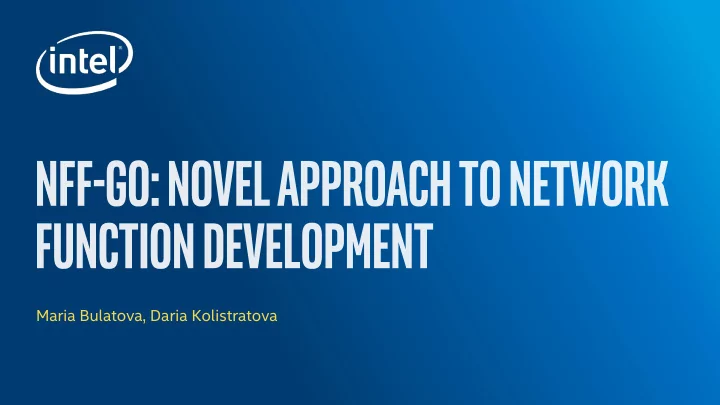

Maria Bulatova, Daria Kolistratova
Background Network Function (NF) – a component of a network infrastructure with well defined interfaces and behavior ( routing, network address translation (NAT), firewall, etc.). Traditional NFs: expensive not flexible not scalable. 2
Background Solution: Network Function Virtualization (NFV) technology. NFV involves implementing network functions in software that can run on industry standard server hardware. VNFs: cheap can be moved to various locations in the network behavior can be changed easily can run in parallel. 3
Problem There are few instruments for NFV development, but no one provides at once: rapid and simple development • easy learning • fast prototyping • not sufficient overhead • scalability • Required easy-to-learn performant framework for NFV development Solution: NFF-Go! 4
NFF-GO DPDK based DPDK stands for Data Plane Development Kit o DPDK is set of highly optimized libraries and drivers to accelerate packet processing o DPDK uses kernel bypass o GO language based • Open Source • Framework • For Network Function Development • By smart chaining of customized, highly optimized, predefined blocks • 5
Current status 6 releases • 488 stars at GitHub • “Pathfinding project with product quality” • Has LPM, NAT, IPSec, anti DDoS, L3 reassemble, KNI support, protocols: • ARP, VLAN, ICMP, UDP, etc. 6
DPDK usage To achieve high- performance we are using DPDK. DPDK is a C library CGO calls are expensive – DPDK functions only for low level Receive, Send store packets in C memory Figure 3. C and GO interaction for packet handling. use pointers to packets without direct calls to C from GO. 7
Flow Functions There is an abstraction – flow function (FF). Each FF is a goroutine pinned to thread by go runtime FFs are cloned to idle Figure 1. Cloning of Flow Functions cores to achieve given speed FFs are chained through lockless rings 8
Packet Processing graph Is built from FFs. Five predefined FFs: receive send stop merge partition copy Figure 2. Blocks in a packet processing graph of user application. The developer can configure their parameters but can’t change the functionality. 9
Packet Processing graph Four user-defined flow functions (and their vector versions): handle handleDrop separate split generate Figure 2. Blocks in a packet processing graph of user application. They get user-defined function as a parameter, acting as a flow function. 10
L3 simple firewall example Config file example: # Source addr, Destination addr, L4 protocol ID, Src port, Dsr port, Decision 10.10.0.5/24 ANY TCP 46 ANY Accept 111.2.0.4/32 ANY TCP 49:122 ANY Accept ANY 21.23.45.10/32 UDP ANY ANY Accept ANY ANY UDP ANY 4080 Accept Receive Separate Send Stop The same app on DPDK is ~ 1500 lines! 11
How to start Join and star us on GitHub https://github.com/intel-go/nff-go Read a developers guide https://github.com/intel-go/nff-go/wiki/Developers- Guide View a tutorial https://github.com/intel-go/nff- go/blob/master/examples/tutorial/YANFF%20tutorial.pdf And start coding! If you have any question, feel free to open issues on GitHub. 12
References NFF-GO on GitHub: https://github.com/intel-go/nff-go DPDK: https://www.dpdk.org/ An article about NFF-GO: https://doi.org/10.1145/3166094.3166111 Ilya Philippov and Areg Melik-Adamyan. 2017. Novel approach to network function development. In Proceedings of the 13th Central & Eastern European Software Engineering Conference in Russia (CEE- SECR '17). ACM, New York, NY, USA, Article 17, 6 pages. About NFV: https://www.etsi.org 13
Backup slides 15
What is NFF-Go NFF-Go is a set of libraries for creating and deploying cloud-native Network Functions (NFs). It simplifies the creation of network functions without sacrificing performance. Higher level abstractions than DPDK. Using DPDK as a fast I/O engine for performance Go language: safety, productivity, performance, concurrency Network functions are application programs not virtual machines Built-in scheduler to auto-scale processing based on input traffic. Both up and down. 16
NFF-Go benefits Easily leverage Intel hardware capabilities: multi-cores, AES-NI, CAT, QAT, • DPDK 10x reduction in lines of code • No need to be an expert network programmer to develop performant • network function Similar performance with C/DPDK per box • No need to worry on elasticity - done automatically • Take advantage of cloud native deployment: continuous delivery, micro- • services, containers 17
Implementation details FFs are chained via lock-free ring buffers. • Clone when buffer is full. • Copy free – buffers transfer only pointers. • FF is a separate goroutine and is bind to exact core. • 18
Go Garbage collector GO language has safe memory release by GC • Real time library based on language with GC? Really? • • Yes, it is not a framework for mission critical latency-sensitive tasks Ok for other tasks • How? • GO GC has comparatively small pauses ~1ms • Packets are in C (DPDK allocated memory) – no garbage • GC can stop everything! Except receives! – They are in C • Packet buffers are enough for stop-the-world for 3ms • 19
Recommend
More recommend